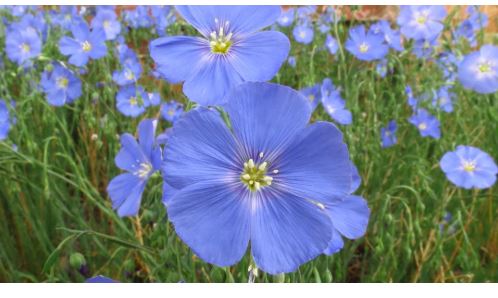
Linum lewisii, commonly known as Blue Flax or Prairie Flax, is a species within the Linum genus of the Linaceae family. This perennial plant is distinct from the flax used for fiber and seed oil (Linum usitatissimum) but shares some similar characteristics, including its slender, erect growth habit. The species name “lewisii” honors Meriwether Lewis, who collected this plant during the Lewis and Clark Expedition.
Blue Flax is native to western North America, with its range extending from Alaska southward to Baja California, and from the Pacific Coast eastward to the Mississippi River. It’s particularly well-adapted to various habitats, including prairies, open woodlands, mountain meadows, and along roadsides, thriving in the dry, well-drained soils of these regions.
The history of Linum lewisii intertwines with the exploration of the American West, as it was first documented by Meriwether Lewis in the early 19th century. While not as extensively used for fiber or oil as its cousin Linum usitatissimum, Blue Flax has been valued for its ornamental beauty and ecological role. Indigenous peoples might have used its seeds for food or its fibers for crafting, although specific uses are less documented than for other plants. In modern times, it’s cultivated for its delicate blue flowers, which provide aesthetic appeal in gardens and support pollinators like bees and butterflies.
Blue Flax is hardy in USDA Hardiness Zones 3 through 8. This range reflects its adaptability to both the cold winters of northern climates and the hot, dry summers of the western U.S. Within these zones, it’s particularly appreciated for its low water needs, making it suitable for xeriscaping, rock gardens, or any garden where drought-resistant plants are desired. Its ephemeral flowers, which open in the morning and often close by midday, add a unique charm to landscapes where native or naturalistic gardening is practiced.
Blue Flax (Linum lewisii): Characteristics
- Flower Appearance: Features small, sky-blue flowers that are about 1 to 1.5 inches across, each with five petals. The flowers are short-lived, opening in the morning and often closing by midday or in the afternoon.
- Bloom Time: Blooms from late spring through early summer, with some varieties potentially blooming sporadically into fall, offering a long season of interest.
- Growth Habit: Grows in an upright, somewhat clumping form, reaching heights of 1 to 3 feet, with slender, wiry stems that give it a delicate appearance.
- Leaves: The leaves are narrow, lanceolate, and mostly basal, with smaller, alternate leaves along the flowering stems. They are green, often with a slight bluish hue.
- Root System: Has a taproot, which helps it anchor well in dry, rocky soils, contributing to its drought tolerance.
- Adaptability: Extremely adaptable to various soil types, from sandy to loamy, as long as they are well-drained. Prefers full sun but can tolerate some shade.
- Pollinator Attraction: Attracts bees, butterflies, and other pollinators with its nectar-rich flowers, contributing to garden biodiversity.
- Longevity: As a perennial, it can return year after year in suitable conditions, though individual plants might be short-lived, with self-seeding ensuring its presence.
- Color Variations: While most commonly blue, there are cultivars with white or pink flowers, though blue remains the predominant color in the wild.
- Ecological Role: Provides habitat and food for various wildlife, including seed-eating birds. Its growth in disturbed or degraded lands also helps in soil stabilization and revegetation efforts.
Blue Flax (Linum lewisii): Cultivation
- Site Selection: Choose a location with full sun for optimal growth and flowering. Blue Flax can tolerate some shade but will bloom best in direct sunlight.
- Soil Preparation: Prefers well-drained, sandy, or loamy soils. Amend heavy or clay soils with sand or organic matter to improve drainage. It’s not particular about soil fertility but does best in lean, unfertile soils.
- Planting: Sow seeds directly outdoors in early spring or late fall for natural stratification. Plant seeds 1/8 inch deep and about 6 to 12 inches apart. Alternatively, start seeds indoors 6-8 weeks before the last frost for transplanting.
- Watering: Water seedlings regularly to ensure establishment. Once established, Blue Flax is drought-tolerant and requires minimal watering, making it ideal for xeriscaping or low-water gardens.
- Mulching: Use a light layer of mulch to help retain soil moisture and reduce weed competition, but avoid heavy mulching which might inhibit seed germination or self-seeding in subsequent years.
- Fertilization: Fertilize sparingly, if at all, since Blue Flax thrives in poor soils. Over-fertilization can lead to lush foliage at the expense of blooms. A light application of a balanced, slow-release fertilizer in early spring might be beneficial if soil is very poor.
- Pruning and Maintenance: Deadheading isn’t necessary for continued blooming as each flower lasts only a day, but removing old flower stems can tidy the plant and encourage new growth. Cutting back after flowering can promote a possible second bloom.
- Pest and Disease Management: Generally resistant to pests and diseases. Good air circulation and well-drained soil help prevent any potential issues. Watch for aphids or spider mites in stress conditions.
- Propagation: Easily propagated by seeds, which can be collected from mature plants for sowing the next season. Division is less common but can be done in early spring or fall.
- Winter Care: In colder zones, a light mulch can protect the taproot from extreme cold, though Blue Flax is quite hardy. No special care is needed in warmer zones where it might act as a short-lived perennial or biennial.